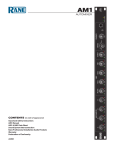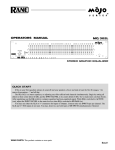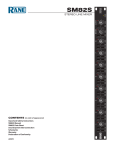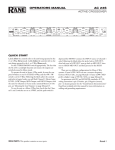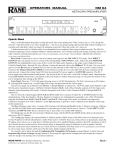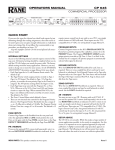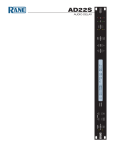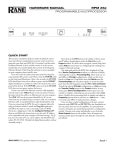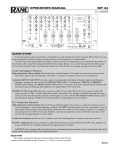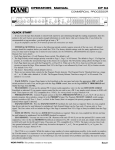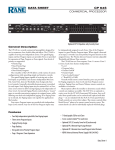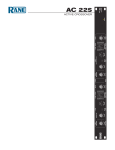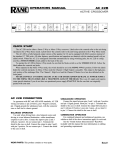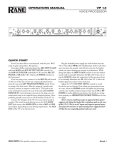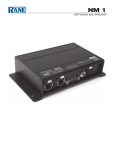Download Rane MOJO MM 8z Installation guide
Transcript
CP52S COMMERCIAL PROCESSOR INSTALLATION GUIDE PAGING INPUT TRIM +30 MIC DETECT THRESHOLD 8 0 OL ACTIVE LIMIT THRESHOLD +8 6 2 +60 LINE PROGRAM INPUT LEVELS LEVEL 4 10 –3 LINE 1 4 +16 6 LINE 2 4 LINE 3 4 6 6 ZONE PRIORITY 4 2 –20 +20 DUCKER DEPTH 6 10 0 10 0 10 0 10 LIMIT OFF L2 L3 + 12 LIMIT THRESHOLD +8 6 2 8 –3 • 6 0 CP52S • 0 +16 COMMERCIAL PROCESSOR • 6 • –20 +20 ON SIG OL L1 EQ LEVEL 4 REMOTE 8 0 PROGRAM SELECT L2 L3 L1 P 12 10 LIMIT 40 100 250 630 1.6k 4k 10k POWER P PROGRAM SELECT 4 6 2 8 0 10 LEVEL ZR1 Program and Level Remote SCP1S Equalizer Security Cover Contents Important Safety Instructions Quick Start General Description CP52S Front Panel CP52S Rear Panel CP52S Connections ZR1 Remote Recommended Calibration Procedure Example System: Restaurant and Lounge Example System: Cardio Fitness Room Technical Support Sound System Interconnection Rane Professional Install Products Block Diagram Limited Domestic Warranty Declaration of Conformity 2 4 5 6 7 8 8 10 14 15 16 17 25 32 33 35 The schematic is downloadable at rane.com/cp52s.html 22274 IMPORTANT SAFETY INSTRUCTIONS 1. Read these instructions. 2. Keep these instructions. 3. Heed all warnings. 4. Follow all instructions. 5. Do not use this apparatus near water. 6. Clean only with a dry cloth. 7. Do not block any ventilation openings. Install in accordance with manufacturer’s instructions. 8. Do not install near any heat sources such as radiators, registers, stoves, or other apparatus (including amplifiers) that produce heat. 9. Do not defeat the safety purpose of the polarized or grounding-type plug. A polarized plug has two blades with one wider than the other. A grounding-type plug has two blades and a third grounding prong. The wide blade or third prong is provided for your safety. If the provided plug does not fit into your outlet, consult an electrician for replacement of the obsolete outlet. 10. Protect the power cord and plug from being walked on or pinched particularly at plugs, convenience receptacles, and the point where it exits from the apparatus. 11. Only use attachments and accessories specified by Rane. 12. Use only with the cart, stand, tripod, bracket, or table specified by the manufacturer, or sold with the apparatus. When a cart is used, use caution when moving the cart/apparatus combination to avoid injury from tip-over. 13. Unplug this apparatus during lightning storms or when unused for long periods of time. 14. Refer all servicing to qualified service personnel. Servicing is required when the apparatus has been damaged in any way, such as power supply cord or plug is damaged, liquid has been spilled or objects have fallen into the apparatus, the apparatus has been exposed to rain or moisture, does not operate normally, or has been dropped. 15. The plug on the power cord is the AC mains disconnect device and must remain readily operable. To completely disconnect this apparatus from the AC mains, disconnect the power supply cord plug from the AC receptacle. 16. This apparatus shall be connected to a mains socket outlet with a protective earthing connection. 17. When permanently connected, an all-pole mains switch with a contact separation of at least 3 mm in each pole shall be incorporated in the electrical installation of the building. 18. If rackmounting, provide adequate ventilation. Equipment may be located above or below this apparatus, but some equipment (like large power amplifiers) may cause an unacceptable amount of hum or may generate too much heat and degrade the performance of this apparatus. 19. This apparatus may be installed in an industry standard equipment rack. Use screws through all mounting holes to provide the best support. WARNING: To reduce the risk of fire or electric shock, do not expose this apparatus to rain or moisture. Apparatus shall not be exposed to dripping or splashing and no objects filled with liquids, such as vases, shall be placed on the apparatus. WARNING CAUTION RISK OF ELECTRIC SHOCK DO NOT OPEN ATTENTION: RISQUE DE CHOCS ELECTRIQUE - NE PAS OUVRIR To reduce the risk of electrical shock, do not open the unit. No user serviceable parts inside. Refer servicing to qualified service personnel. The symbols shown below are internationally accepted symbols that warn of potential hazards with electrical products. This symbol indicates that a dangerous voltage constituting a risk of electric shock is present within this unit. This symbol indicates that there are important operating and maintenance instructions in the literature accompanying this unit. WARNING: This product may contain chemicals known to the State of California to cause cancer, or birth defects or other reproductive harm. NOTE: This equipment has been tested and found to comply with the limits for a Class B digital device, pursuant to part 15 of the FCC Rules. These limits are designed to provide reasonable protection against harmful interference in a residential installation. This equipment generates, uses and can radiate radio frequency energy and, if not installed and used in accordance with the instructions, may cause harmful interference to radio communications. However, there is no guarantee that interference will not occur in a particular installation. If this equipment does cause harmful interference to radio or television reception, which can be determined by turning the equipment off and on, the user is encouraged to try to correct the interference by one or more of the following measures: • Reorient or relocate the receiving antenna. • Increase the separation between the equipment and receiver. • Connect the equipment into an outlet on a circuit different from that to which the receiver is connected. • Consult the dealer or an experienced radio/TV technician for help. CAUTION: Changes or modifications not expressly approved by Rane Corporation could void the user's authority to operate the equipment. This Class B digital apparatus complies with Canadian ICES-003. 2 INSTRUCTIONS DE SÉCURITÉ 1. Lisez ces instructions. 2. Gardez précieusement ces instructions. 3. Respectez les avertissements. 4. Suivez toutes les instructions. 5. Ne pas utiliser près d’une source d’eau. 6. Ne nettoyer qu’avec un chiffon doux. 7. N’obstruer aucune évacuation d’air. Effectuez l’installation en suivant les instructions du fabricant. 8. Ne pas disposer près d’une source de chaleur, c-à-d tout appareil produisant de la chaleur sans exception. 9. Ne pas modifier le cordon d’alimentation. Un cordon polarisé possède 2 lames, l’une plus large que l’autre. Un cordon avec tresse de masse possède 2 lames plus une 3è pour la terre. La lame large ou la tresse de masse assurent votre sécurité. Si le cordon fourni ne correspond pas à votre prise, contactez votre électricien. 10. Faites en sorte que le cordon ne soit pas piétiné, ni au niveau du fil, ni au niveau de ses broches, ni au niveau des connecteurs de vos appareils. 11. N’utilisez que des accessoires recommandés par Rane. 12. N’utilisez que les éléments de transport, stands, pieds ou tables spécifiés par le fabricant ou vendu avec l’appareil. Quand vous utlisez une valise de transport, prenez soin de vous déplacer avec cet équipement avec prudence afin d’éviter tout risque de blessure. 13. Débranchez cet appareil pendant un orage ou si vous ne l’utilisez pas pendant un certain temps. 14. Adressez-vous à du personnel qualifié pour tout service après vente. Celui-ci est nécessaire dans n’importe quel cas où l’appareil est abimé : si le cordon ou les fiches sont endommagés, si du liquide a été renversé ou si des objets sont tombés sur l’appareil, si celui-ci a été exposé à la pluie ou l’humidité, s’il ne fonctionne pas correctement ou est tombé. 15. La fiche du cordon d’alimentation sert à brancher le courant alternatif AC et doit absolument rester accessible. Pour déconnecter totalement l’appareil du secteur, débranchez le câble d’alimentation de la prise secteur. 16. Cet appareil doit être branché à une prise terre avec protection. 17. Quand il est branché de manière permanente, un disjoncteur tripolaire normalisé doit être incorporé dans l’installation électrique de l’immeuble. 18. En cas de montage en rack, laissez un espace suffisant pour la ventilation. Vous pouvez disposer d’autres appareils au-dessus ou en-dessous de celui-ci, mais certains (tels que de gros amplificateurs) peuvent provoquer un buzz ou générer trop de chaleur au risque d’endommager votre appareil et dégrader ses performances. 19. Cet appareil peut-être installé dans une baie standard ou un chassis normalisé pour un montage en rack. Visser chaque trou de chaque oreille de rack pour une meilleure fixation et sécurité. ATTENTION: afin d’éviter tout risque de feu ou de choc électrique, gardez cet appareil éloigné de toute source d’humidité et d’éclaboussures quelles qu’elles soient. L’appareil doit également être éloigné de tout objet possédant du liquide (boisson en bouteilles, vases,…). ATTENTION CAUTION RISK OF ELECTRIC SHOCK DO NOT OPEN ATTENTION: RISQUE DE CHOCS ELECTRIQUE - NE PAS OUVRIR Afin d’éviter tout risque de choc électrique, ne pas ouvrir l’appareil. Aucune pièce ne peut être changée par l’utilisateur. Contactez un SAV qualifié pour toute intervention. Les symboles ci-dessous sont reconnus internationalement comme prévenant tout risque électrique. Ce symbole indique que cette unité utilise un voltage élevé constituant un risque de choc électrique. Ce symbole indique la présence d’instructions d’utilisation et de maintenance importantes dans le document fourni. REMARQUE: Cet équipement a été testé et approuvé conforme aux limites pour un appareil numérique de classe B, conformément au chapitre 15 des règles de la FCC. Ces limites sont établis pour fournir une protection raisonnable contre tout risque d’interférences et peuvent provoquer une énergie de radiofréquence s'il n'est pas installé et utilisé conformément aux instructions, peut également provoquer des interférences aux niveaux des équipements de communication. Cependant, il n'existe aucune garantie que de telles interférences ne se produiront pas dans une installation particulière. Si cet équipement provoque des interférences en réception radio ou télévision, ceci peut être detecté en mettant l'équipement sous/hors tension, l'utilisateur est encouragé à essayer de corriger cette interférence par une ou plusieurs des mesures suivantes: • Réorienter ou déplacer l'antenne de réception. • Augmenter la distance entre l'équipement et le récepteur. • Connecter l'équipement à une sortie sur un circuit différent de celui sur lequel le récepteur est branché. • Consulter un revendeur ou un technicien radio / TV expérimenté. ATTENTION: Les changements ou modifications non expressément approuvés par Rane Corporation peuvent annuler l'autorité de l'utilisateur à manipuler cet équipement et rendre ainsi nulles toutes les conditions de garantie. Cet appareil numérique de classe B est conforme à la norme Canadienne ICES-003. Cet appareil numérique de classe B est conforme à la norme Canadienne NMB-003. 3 CP52S COMMERCIAL PROCESSOR PAGING INPUT TRIM +30 MIC DETECT THRESHOLD 8 0 OL ACTIVE LIMIT THRESHOLD +8 6 2 +60 LINE PROGRAM INPUT LEVELS LEVEL 4 10 –3 +16 –20 +20 LINE 1 4 6 LINE 2 4 6 LINE 3 4 6 ZONE PRIORITY 4 DUCKER DEPTH 6 2 10 0 10 0 10 0 10 OFF LIMIT Quick Start If you were the type that cheated on school book reports by just skimming through the reading assignments, then this section is for you! It gives you not quite enough information to really know what you’re doing. But, if you follow the recommended set up procedure, you should get at least a “B.” Keep the amplifiers and the CP52S turned off until all connections are made. PAGE INPUT Connect the PAGING INPUT to the Euroblock on the rear panel. On the front, select the appropriate MIC or LINE switch position. Then set the gain with the INPUT TRIM control, then set the PAGING DETECT THRESHOLD and finally the PAGING LEVEL. MIC PHANTOM POWER, HIGH/LOW CUT FILTER and PAGE LEVEL TRACKS ZONE LEVEL switches are located on the rear panel. PROGRAM INPUTS Connect line level program sources to the RCA PROGRAM INPUT jacks (LINE L1, L2, L3 & PRIORITY). If you have a priority program, like a jukebox, connect it to the PRIORITY Input. The rear panel PRIORITY switch turns priority override ON or OFF. The Priority program is automatically selected when signal is detected at its Input. Set the rear panel PROGRAM DETECT THRESHOLD and RELEASE TIME as desired. WEAR PARTS: This product contains no wear parts. 4 EQ LEVEL 4 REMOTE 8 0 PROGRAM SELECT L2 L3 L1 P LIMIT THRESHOLD +8 6 2 8 –3 +16 0 SIG OL • 6 CP52S • 0 COMMERCIAL PROCESSOR • 6 –20 +20 ON + 12 10 LIMIT • 12 40 100 250 630 1.6k 4k 10k POWER EXPAND OUTPUT Wire the EXPAND OUTPUT Euroblock as required to a mono feed delivering PAGE-only, PROGRAM-only or ZONE (both) signal depending on the switch setting. This Output uses a crosscoupled line driver and may be used balanced or unbalanced. Adjust the EXPAND OUTPUT LEVEL trim as desired. ZONE OUTPUT The ZONE OUTPUT uses a cross-coupled line driver and may be used balanced or unbalanced. Set the front panel LIMIT THRESHOLD as required. Depress the rear panel MONO switch for a mono Zone. ZR1 REMOTE You may use one ZR1 Remote (sold separately) with the CP52S. Wire it to the ZONE REMOTE Euroblock as indicated. If a ZR1 remote is not used, any simple switch closure to ground will work for the D0 and D1 pins. These pins are TTL compatible (0 to 5 VDC). The logic is inverse Gray Code. Any ground referenced 5 volt DC control may be used as the input to Vc. Do not ground the Vr pin. READ ME The CP52S is very versatile. While this makes a large number of system applications possible, it also results in complexity. For this reason, it is important to use an organized approach for setup and calibration. A highly recommended setup is at "Recommended Calibration Procedure" on page 10. Please follow it to encounter fewer problems and reduce the need to increase our collective phone bills. CP52S COMMERCIAL PROCESSOR SCP1S Equalizer Security Cover General Description The CP52S is a versatile commercial preamplifier designed for use in restaurants, bars, health clubs and offices. The CP52S serves one stereo Zone. One gated Paging Input and four stereo Program Inputs are provided. A Port allows expansion of Page, Program or Zone signals. Three levels of priority are supported: 1. Page 2. Program Priority 3. Non-Priority Program The Paging Input is summed after Zone Level, Zone EQ and Zone Limiter circuits. If the Page Level Tracks Zone Level switch is on, the Page level tracks the Zone Level. One of four stereo Program Inputs may be selected. Each line level Program Input features an independent Level control. A gated Program Priority Input is provided. When the rear panel Priority switch is ON and signal is detected at the Priority Input, it overrides any non-priority Program selection. The detector features adjustableDetect Threshold and Release Time controls. Several levels of security are available. The SC 1.7 is an optional security cover for the entire unit. The SCP1S is an optional EQ-slider-only security cover. Any front panel control knobs may be removed and replaced with hole plugs provided with the SCP1S. Gated Paging Circuit Features • • • • • • • Mic/Line Selection with Gain Trim Phantom Power Switch Low / High Cut Filter Switch Adjustable Detector Threshold with Active LED Paging Level Control Switchable Page Level Tracks Zone Level Page Input Servo-Locked™ Limiter Zone Output Features • • • • • • Level Control 1 of 4 Program Select Ducker On/Off with Depth Control Output Servo-Locked™ Limiter 7-Band Equalizer (±12 dB) Wired Zone Remote Port for Level and Program Selection Special Features • • • • Page Initiated Program Ducking Gated Stereo Program Priority Input Page/Program/Zone Expansion with Level Control Universal internal switching power supply (100-240 VAC) 5 CP52S Front Panel 1 3 6 INPUT TRIM DETECT THRESHOLD 3 9 11 PAGING +30 MIC 2 8 0 OL ACTIVE 4 5 LIMIT THRESHOLD +8 6 2 +60 LINE PROGRAM INPUT LEVELS LEVEL 4 10 13 –3 +16 –20 +20 LINE 1 4 6 LINE 2 4 LINE 3 4 6 6 ZONE PRIORITY 4 DUCKER DEPTH 6 2 PROGRAM SELECT L2 L3 L1 P 10 0 0 10 10 0 10 OFF 8 –3 +16 0 + 12 • 6 CP52S • 0 COMMERCIAL PROCESSOR • 6 –20 +20 SIG OL 10 LIMIT THRESHOLD +8 6 2 ON LIMIT 8 EQ LEVEL 4 REMOTE 8 0 14 10 LIMIT • 12 40 12 100 250 630 1.6k 4k 10k 15 POWER 16 1 PAGING INPUT TRIM control adjusts the Page Input preamplifier gain to match the microphone / source in use. The range is 30 dB to 60 dB. 2 PAGING INPUT MIC / LINE switch selects a 30 dB Input pad when set to LINE. Phantom Power is disabled when LINE is selected. 3 PAGING DETECT THRESHOLD sets the Page signal level required to gate a Page on and illuminate the ACTIVE indicator (see 5). The range is -∞ (on) to +4 dBu. 4 PAGING OL (Overload) indicator lights when the Page Input preamplifier comes within 3 dB of clipping. 5 PAGING ACTIVE indicator lights when the Page signal level reaches the PAGING DETECT THRESHOLD. A Page is always Active when the PAGING DETECT THRESHOLD is set to minimum (ccw). 6 PAGING LEVEL control adjusts the Paging Level in the Zone. 7 PAGING LIMIT THRESHOLD control sets the maximum output level for a Page. This is a true voltage Limiter circuit with a ratio of 15:1. The Threshold range is -20 dBu to +20 dBu. The LIMIT indicator lights during limiting. 8 PROGRAM INPUT LEVELS allow independent adjustment of level for each Program Input. 9 ZONE DUCKER DEPTH control sets the Ducker Depth (the amount of Program attenuation during a Page) from 50 dB (ccw) to 6 dB (cw). The Ducker release is ramped. 0 ZONE DUCKER OFF / ON switch turns the Ducker ON or OFF. q ZONE PROGRAM SELECT switch assigns one of four Program Inputs to the Zone Output, only when w is out. w ZONE REMOTE switch, when pushed in, turns control of Zone Level and Zone Program Selection over to the Zone Remote Port. Front panel ZONE LEVEL and ZONE PROGRAM SELECT controls are inactive when REMOTE is selected. An optional wired ZR1 remote may be connected to the Zone Remote Port. An object smaller in diameter than the switch button is required to engage the REMOTE switch. e ZONE LEVEL control adjusts the overall Level for the Zone Output. If the rear panel PAGE LEVEL TRACKS ZONE LEVEL switch is ON, this control also effects the Paging Level. ZONE SIG and OL indicators assist in setting the LEVEL control, illuminating with Signal present at -20 dBu and Overload at +16 dBu (4 dB before clipping) respectively. r ZONE LIMIT THRESHOLD control sets the maximum level for the Zone Output. This is a true voltage Limiter circuit with a ratio of 15:1. The Threshold range is -20 dBu to +20 dBu. The LIMIT indicator lights during Limiting. t Graphic Equalizer controls are “stereo,” with each slider controlling the response of both Left and Right channels. These controls allow ±12 dB adjustment of seven ISO center frequencies on 11/3 -octave centers. y POWER indicator illuminates when the CP52S is connected to a proper power source. 6 CP52S Rear Panel CP52S COMMERCIAL AUDIO EQUIPMENT 24TJ 100-240 V 50/60 Hz 12 WATTS R ZONE REMOTE PROGRAM D1 D0 LEVEL MIN MAX Vr Vc ZONE OUTPUT RIGHT + – EXPAND OUTPUT LEFT + – EXPAND MONO + – LEVEL PRIORITY RELEASE 5 ZONE PAGE MADE IN U.S.A. RANE CORP. 15 D1 D0 Vr Vc 14 + – + 13 – + – 12 11 DETECT THRESHOLD SOURCE SEC 20 PROGRAM 2 INPUTS PAGING INPUT 1 L R OFF R PAGE LEVEL TRACKS ZONE LEVEL OFF ON ON LOW / HIGH CUT FILTER OUT IN 100 Hz / 7 kHz MIC PHANTOM POWER OFF 9 8 7 6 5 4 3 INPUT + – + – ON +15V ALL AUDIO AND REMOTES ARE CLASS 2 WIRING PROGRAM 10 3 L 2 1 1 PAGING INPUT Euroblock connector may be wired per instructions in"CP52S Connections" on page 8. 2 MIC PHANTOM POWER switch, when ON, enables +15 volt Phantom Power to the PAGING INPUT connector. If the front panel LINE switch is selected, Phantom Power is defeated. 3 LOW / HIGH CUT FILTER switch, when IN, limits the bandwidth of the Paging Input from 100 Hz to 7 kHz, improving intelligibility in some installations. The Paging detector is always bandlimited to 100 Hz to 7 kHz. 4 PAGE LEVEL TRACKS ZONE LEVEL switch, when ON, forces the Paging level to track the Zone level. When OFF, Paging level and Zone level are independent. 5 Four PROGRAM INPUTS are provided. Three are non-priority Inputs — the fourth is a Program PRIORITY Input. When signal is detected at this Input, it is automatically selected as the Program Input source regardless of the front panel PROGRAM SELECT setting. 6 PRIORITY DETECT THRESHOLD control allows adjusting the threshold from -∞ (signal on) to -35 dBu (typ). The factory setting is -50 dBu. 7 PRIORITY OFF/ON switch allows disabling the automatic priority override function when in the OFF position. 8 PRIORITY RELEASE TIME control sets the delay time from last detected signal to release of automatic priority override. The range of control is 5 seconds (ccw) to 20 seconds (cw). 9 EXPAND LEVEL trim adjusts the signal level delivered to the ZONE EXPAND OUTPUT. 0 EXPAND SOURCE switch assigns PAGE-only, PROGRAM-only or full ZONE (both) as the source for the Expand Output. q EXPAND OUTPUT features a balanced line driver with a Euroblock connector. This mono Output may be wired balanced or unbalanced per the instructions in "CP52S Connections" on page 8. w ZONE MONO switch, when pressed in, sums the left and right signals to provide a mono Zone signal available at both Left and Right Outputs. e ZONE OUTPUT Port features a balanced line driver with a Euroblock connector. These Left and Right Outputs may be wired balanced or unbalanced per the instructions in"CP52S Connections" on page 8. r ZONE REMOTE Port provides the wiring interface for the optional ZR1 wired remote. The ZR1 remote provides remote control of Zone Level and Zone Program Select functions. See "ZR1 Remote" on page 8. t Universal Voltage Input: via a miniature IEC 60320 C6 appliance inlet. This mates with an IEC 60320 C5 line cord (USA domestic). Do not lift the ground connection! 7 CP52S COMMERCIAL PROCESSOR CP52S Connections ZR1 Remote All Input and Output connections are made with Euroblock connectors except for the RCA Program Inputs. When wiring to Euroblocks, a minimum wire gauge of 22 is preferred for reliability. If the ground or shield wire is left shorter, it acts as a strain relief for the other wires. Cable with a flexible jacket is easier to use and less likely to damage the connections. Avoid stripping excess insulation. Inspect wires for nicks that may lead to wire breakage. Fully insert each wire in the appropriate socket and tighten the screw. The Page Input is a true instrumentation amplifier and operates balanced or unbalanced. Expand and Zone Outputs are driven by high quality cross-coupled line drivers and operate balanced or unbalanced. Wiring is usually the same for both Inputs and Outputs. Balanced operation is recommended, and necessary when wire lengths are greater than 10 feet (3 meters). Balanced wiring is logical, (+) to (+), (–) to (–) and shield to shield. For unbalanced operation, we recommend using two conductor cable with shield. The cable is wired to the CP52S the same as for balanced operation. At the other end of the cable, connect the (+) wire to signal “hot,” and both the (–) and shield wires to ground (important). If you use single conductor cable with shield, connect the shield/gnd wire to both the (–) and shield pins at the CP52S. At the other end of the cable connect the (+) wire to the signal “hot” and the shield/gnd wire to ground. When unbalanced wiring is used, it is very important for the CP52S and any other unit in the system to have good earth or technical grounds. If a unit is located more than 10 feet (3 meters) away from the CP52S or is of a type that might create grounding problems, use isolation transformers. When connecting any CP52S Output as unbalanced, use (+) and ground — leave (–) floating. Depending on building grounding, an occasional source of system hum is powering sources and amplifiers on different electrical circuits. Try connecting everything on the same circuit. Refer to the included RaneNote, "Sound System Interconnection" on page 17 for more information on proper wiring procedures. The CP52S supports a wired remote for Zone Level and Zone Source selection. Wire lengths of up to 1000 feet (300 meters) are possible. A brief list of suitable wire types is provided here in the Wire Types section. The ZR1 remote provides Zone Level and Source Selection, allowing local control from inside the Zone. If only one of the two controls is used, you may wish to remove the unused knob and cover the hole with one of the plugs provided in the kit. If you require one ZR1 remote to control more than one unit, simply wire the ports in parallel. This may be done with the Selector only, Level only or both. Be sure Power to the CP52S is off while all remote connections are made. It is important to ensure that the CP52S Remote Port is not subjected to sustained voltages outside the range of 0 to 5 volts DC or high levels of static. Inputs are protected—however, caution is the better part of... you know. It is a good idea to install the wiring, connect it to the remote assemblies and then make the final connections at the CP52S. Do not short the Vr pin to ground. Although the pin is current limited, excess heat will be generated in the 5 volt supply if a short occurs. Never subject the Vr pin to voltages above 5V. If a ZR1 remote is not used, any simple switch closure to GND will work for the D0 and D1 pins. These pins are TTL compatible (0 to 5 VDC). The logic is inverse Gray Code. Any ground referenced 5 volt DC control may be used as the input to Vc. Do not ground the Vr pin. CP52S COMMERCIAL AUDIO EQUIPMENT 24TJ 100-240 V 50/60 Hz 12 WATTS R ZONE REMOTE PROGRAM D1 D0 LEVEL MIN MAX Vr Vc ZONE OUTPUT RIGHT + – EXPAND OUTPUT LEFT + – EXPAND MONO + – LEVEL PRIORITY RELEASE ZONE PAGE 8 D1 D0 Vr Vc + – + – + – DETECT THRESHOLD SOURCE 5 MADE IN U.S.A. RANE CORP. Remote Selector 11=LINE 1 10=LINE 2 00=LINE 3 01=PRIORITY PROGRAM SEC 20 3 L R OFF Remote Volume 2 kΩ pot, reverse-log taper Or any GND referenced 0-5 VDC. Attenuation=64 mV/dB. Range 0V to +5V (0 to -87 dB). PROGRAM 2 INPUTS PAGING INPUT 1 L R ON ALL AUDIO AND REMOTES ARE CLASS 2 WIRING PAGE LEVEL TRACKS ZONE LEVEL OFF ON LOW / HIGH CUT FILTER OUT IN 100 Hz / 7 kHz MIC PHANTOM POWER OFF INPUT + – + – ON +15V CP52S COMMERCIAL PROCESSOR S1B 10 PROGRAM SELECT Zone / Level 4 6 0 10 2 8 LEVEL D0 1 S1A 5 2 3 CW 3 ZR1 P D1 Vc 4 2 4 3 2 1 GND GND R1 2KRD 1 L1 Decora plate (not included) J1A L2 L3 9 8 7 6 GND Vr 5 5 POS TERM ZONE REMOTE (ZR 1) assembly and silk-screened front panel to the electrical box (see diagram, next page). Note the “UP” arrow screened on the printed circuit board of the remote (mount it pointing up). Install each knob so that the line on the knob is properly aligned with the silk-screening on the front panel of the remote assembly. Install any Decora plate of your choice. For a secured installation, you may wish to leave the knobs off and use a blank Decora plate to cover the remote after adjustment. VR1 Level LEVEL 4 6 0 10 2 8 VR1 LEVEL REMOTE Rane provides the VR1 Volume Remote for applications that require a remote level control without the program selector found in the ZR1. It contains the same 2k RD taper pot, and connects as shown in the ZR1 schematic. With the front panel REMOTE switch, all selection and level is done either on the front panel or at the remote; never both locations. Connecting just a VR1 to the CP52S remote control terminals will allow level adjustment. However without a source selector, the unit will default to source one. If the PRIORITY / L4 INPUT automatic switching is enabled, then the unit will select the L4 signal when present and L1 at any other time. Thus if only a jukebox (P/L4) and other line source (L1) are used, the remote volume control will work just fine. REMOTE MOUNTING The ZR1 or VR1 remote assembly mounts in a standard U.S. electrical box with a minimum depth of 2.25". Be sure to note the wire color of each input in order to facilitate correct wiring to the CP52S. Connect each wire to the connector by fully inserting it in the correct socket and tightening the screw. Make sure the cable jacket is stripped back sufficiently to allow it to lie in the electrical box with the remote assembly inserted. Use the flat head #6 screws supplied with the kit to mount the remote WIRE TYPES Though variations in wire type do not greatly affect the performance of the remote controls, 22-gauge stranded wire with a flexible jacket is recommended. You may use 5-conductor unshielded remote control signal cable for short runs (less than 200 feet [60 meters]) or 4-conductor (2 pair) shielded remote control signal cable (use the shield as the ground return) for long runs (200 to 1000 feet [60 to 300 meters]). The type of wire required is influenced by your installation and local electrical codes. Rane Corporation does not provide or source cable. Please contact your local retail or wholesale outlet, not the factory. The following is a short list of suitable cable types: CONSOLIDATED ELECTRONIC WIRE AND CABLE Plenum cable: Unshielded remote control signal cable CAT. # 9896 Shielded remote control signal cable CAT. #9877, CAT. #9852 WEICO WIRE & CABLE INC. Communication and control cable: Multiconductor, unshielded CAT. #7606 ALPHA Communication and control cable: Multiconductor, unshielded CAT. #1175C BELDEN Unshielded remote control signal cable CAT. # 88741 Shielded remote control signal cable CAT. # 88723 9 Recommended Calibration Procedure The CP52S is a very versatile instrument. While this allows it to conform to the requirements of a large number of system applications, it also results in complexity. For this reason, it is very important to use an organized approach to system calibration. Once the system is connected, take the time for proper calibration. The following is an ordered list of system adjustments to make calibration easy with optimum performance results. This procedure assumes that a microphone is used for the Page. The procedure (except for the exact wording) is the same for other Page sources. Make sure the POWER is off! PAGING INPUT TRIM +30 MIC DETECT THRESHOLD 8 0 –3 10 +16 –20 +20 COMMERCIAL AUDIO EQUIPMENT 24TJ 100-240 V 50/60 Hz 12 WATTS R LINE 1 4 6 LINE 2 4 LINE 3 4 6 6 ZONE PRIORITY 4 DUCKER DEPTH 6 2 ZONE REMOTE PROGRAM D1 D0 0 10 0 0 10 10 0 10 OFF LEVEL MIN MAX Vr Vc ZONE OUTPUT – Vr Vc + – 8 –3 0 EXPAND OUTPUT LEFT + – EXPAND MONO + – LEVEL + – + – DETECT THRESHOLD SOURCE 20 OFF COMMERCIAL PROCESSOR • 6 • 12 LIMIT 3 CP52S • 0 +16 10 PRIORITY RELEASE SEC • 6 –20 +20 ON ZONE PAGE D1 D0 2 + 12 LIMIT THRESHOLD +8 6 SIG OL RIGHT + EQ LEVEL 4 REMOTE 8 5 MADE IN U.S.A. RANE CORP. PROGRAM SELECT L2 L3 L1 P LIMIT ACTIVE OL CP52S LIMIT THRESHOLD +8 6 2 +60 LINE PROGRAM INPUT LEVELS LEVEL 4 40 PROGRAM 2 INPUTS 100 L R R 630 PAGE LEVEL TRACKS ZONE LEVEL OFF ON ON LOW / HIGH CUT FILTER OUT IN 100 Hz / 7 kHz ALL AUDIO AND REMOTES ARE CLASS 2 WIRING PROGRAM PREFLIGHT CONTROL SETTINGS PAGING SETTINGS: • MIC/LINE Pad • INPUT TRIM • DETECT THRESHOLD • PAGING LEVEL • LIMIT THRESHOLD • MIC PHANTOM POWER • LOW / HIGH CUT FILTER • PAGE LEVEL TRACKS ZONE LEVEL As required 12:00 (center) Min (ccw, Active) Min +20 dBu As required As required OFF (front panel) (front panel) (front panel) (front panel) (front panel) (rear panel) (rear panel) (rear panel) PROGRAM INPUT SETTINGS: • Input Levels • PRIORITY DETECT THRESHOLD • PRIORITY RELEASE TIME • PRIORITY OFF / ON Min Set to -50 dBu at factory Set to 12 sec. at factory OFF (front panel) (range -∞ to -35 dBu; rear panel) (range 5 to 20 sec; rear panel) (rear panel) ZONE SETTINGS: • DUCKER DEPTH 2:00 (about 15 dB) (front panel) • DUCKER OFF / ON OFF (front panel) LINE 1, 2, 3 or P (Any active Input; front panel) • PROGRAM SELECT Out (local control) (front panel) • REMOTE Max (front panel) • Zone LEVEL +20 dBu (front panel) • LIMIT THRESHOLD • EqualizerFlat(front panel) As required (rear panel) • Zone Output MONO As required (rear panel) • Expand ZONE/PROGRAM/PAGE SYSTEM CONNECTIONS • Connect page microphone or line level paging source • Connect Program sources • Connect Output to amps • Connect ZR1 Remote control (if required) ...You are now ready to calibrate the CP52S (continued on next page...) 10 1.6k 4k POWER 10k PAGING INPUT 1 L 250 MIC PHANTOM POWER OFF INPUT + – + – ON +15V CP52S COMMERCIAL PROCESSOR PAGING INPUT TRIM +30 MIC DETECT THRESHOLD 8 0 –3 10 +16 –20 +20 COMMERCIAL AUDIO EQUIPMENT 24TJ 100-240 V 50/60 Hz 12 WATTS R LINE 1 4 6 LINE 2 4 LINE 3 4 6 6 ZONE PRIORITY 4 DUCKER DEPTH 6 2 ZONE REMOTE PROGRAM D1 D0 0 10 0 0 10 10 0 10 OFF LEVEL MIN MAX Vr Vc RIGHT – Vr Vc + – 8 LEFT + – EXPAND MONO + – LEVEL ON 0 + – + – 0 +16 RELEASE DETECT THRESHOLD SOURCE 20 OFF COMMERCIAL PROCESSOR • 6 • 12 LIMIT 3 CP52S • 10 PRIORITY SEC –3 • 6 –20 +20 EXPAND OUTPUT ZONE PAGE D1 D0 2 + 12 LIMIT THRESHOLD +8 6 SIG OL ZONE OUTPUT + EQ LEVEL 4 REMOTE 8 5 MADE IN U.S.A. RANE CORP. PROGRAM SELECT L2 L3 L1 P LIMIT ACTIVE OL CP52S LIMIT THRESHOLD +8 6 2 +60 LINE PROGRAM INPUT LEVELS LEVEL 4 40 PROGRAM 2 INPUTS 100 L R R PAGE LEVEL TRACKS ZONE LEVEL OFF ON ON PROGRAM 630 1.6k 4k POWER 10k PAGING INPUT 1 L 250 ALL AUDIO AND REMOTES ARE CLASS 2 WIRING LOW / HIGH CUT FILTER OUT IN 100 Hz / 7 kHz MIC PHANTOM POWER OFF INPUT + – + – ON +15V CALIBRATION 1. Connect the power supply and verify the POWER indicator lights. 2. Verify the Zone LEVEL control is set to maximum and that an active source is playing for each of the Program Inputs intended for use. Select each Program Input and adjust its Input Level control to be the very loudest you would ever desire. 3. Adjust the Zone LIMIT THRESHOLD so that it just starts to audibly reduce the output level. This ensures that the level will never be louder than the maximum level just set. 4. Turn the Zone LEVEL control down to a comfortable listening level. 5. Note that with the Paging LEVEL set to minimum, the following Page will not be heard. Speak very loudly (bark) into the Paging mic. Adjust the INPUT TRIM control so that the Paging Overload indicator just lights. It is important to set the gain of the preamp before setting the Paging Detect Threshold. 6. Speak into the Paging mic in a normal voice and adjust the Paging DETECT THRESHOLD so the ACTIVE indicator lights only during speech. If the Paging Detect Threshold is set too low, the Pager may gate on due to background sound. 7. With an active Program source playing, speak into the Paging mic. Adjust the Paging LEVEL control to provide the correct Pageto-Program mix. If the Paging Detect Threshold is set too high, there may be a delay before speech is heard. To correct this, lower the Paging Detect Threshold setting. 8. Set the Paging LIMIT THRESHOLD to limit the maximum Page level to the loudest desired volume. 9. Set the DUCKER switch to ON. With an active Program source playing, speak into the Page mic and adjust the DUCKER DEPTH to the desired level of Program during a Page. 10. Set the rear panel Program PRIORITY OFF / ON switch as required. If an automatic Program Priority override is not required, set this switch to OFF. The front panel PROGRAM SELECT switch will select the “P” Program Input just like any other nonpriority Input. 11. If using a ZR1 Remote, press the ZONE REMOTE switch in and verify that the remote functions correctly (see page 6). 12. Adjust the Equalizer as desired. SECURITY Rane offers a few options to protect the settings you just made. To protect the equalizer section, use a Rane SCP1S security cover. To protect the setting of any rotary control, remove the knob and replace with one of the hole plugs included with the SCP1S. To protect the entire front panel and allow operation with only the ZR1 Remote, use a Rane SC 1.7. You’re all set. Enjoy. 11 CP52S COMMERCIAL PROCESSOR Specifications Parameter MIC/LINE PAGING INPUT ..........Input Type ..........RFI Filter ..........Gain range ..........Frequency Response ..........Input Referred Noise ..........CMRR ..........THD+NS Specification ..........Phantom Power ..........“Mic” Input impedance ..........Line Pad ..........“Line” Input impedance ..........Signal Detector Attack ..........Signal Detector Release ..........Overload Detector ..........Low Cut / Hi Cut Filters ..........Paging Zone Level Adjust ..........Page Limiter: Threshold Range ...............Attack Time ...............Release Time ...............Ratio PROGRAM INPUTS ..........Number of Inputs ..........Input Type ..........Input Level Adjust ..........Frequency Response ..........Input Impedance ..........Priority Program Input ...............Input Detector Range ...............Release Time Range ...............Attack Time +15 500 30 14.5k 10 3 +16 100 & 7k Off to 0 -20 to +20 20 250 15:1 12 Balanced Yes +30 to +60 30 to 40k -125 40 .05 Four Unbalanced Off to 0 10 to 50k 10k 5 to 20 50 Limit Units Conditions/Comments Instrumentation amplifier 2 typ 1 min .01 dB Hz dBu dB % 4% 1% 1 1% typ typ 1 5 VDC Ω dB Ω msec sec dBu Hz dB dBu msec msec typ typ typ typ Continuously adjustable Maximum gain, +0, -3 dB Gain: 60 dB, Rs:150 Ω, BW: 20 kHz 20 Hz to 20 kHz Gain: 30 dB, +4 dBu out, 1 kHz, BW: 80 kHz Each leg to ground Defeats phantom power Each leg to ground Fixed; 10 dB overdrive Fixed 4 dB before clipping Selectable In/Out Continuously adjustable For a 10 dB step; fixed For a 10 dB step; fixed Soft knee All controls duplicated for each input Stereo RCA connector typ 20 dB Hz Ω +0, -3 dB typ typ typ dBu sec msec On rear panel; factory set to -50 dBu On rear panel; factory set to 15 seconds For a 20 dB step; fixed CP52S COMMERCIAL PROCESSOR Parameter OUTPUTS: Type ..........Zone Out Gain: Program In ...............From Page Inputs ..........Expand Out Gain: Zone ...............From Page or Program In ..........Frequency Response ..........S/N ..........THD+N ..........Crosstalk ..........Output Impedance ..........Zone Maximum Output ..........Expand Maximum Output ..........Signal Present ..........Overload Detector ..........Ducker: Depth Range ...............Ramped Release ..........Limiter: Threshold Range ..............Attack Time ..............Release Time ..............Ratio EQUALIZER: Boost/Cut Range ..........ISO Center Frequencies UNIT: Maximum Power ..........Universal Line Voltage ..........Conformity ..........Construction ..........Size ..........Weight SHIPPING: Size ..........Weight Note: 0 dBu = 0.775 Vrms Specification Balanced 16 6 16 6 10 to 40k 84 .1 -75 100 20 24 -20 +16 -50 to -6 10 -20 to +20 20 250 15:1 ±12 1 1/3 12 100-240 CE, FCC, CULUS All Steel 1.75"H x 19"W x 8.5"D 5 lb 4.5" x 20.3" x 13.75" 9 lb Limit Units 1 1 1 1 typ min max max 1% typ typ typ typ typ typ typ typ typ typ .5 typ dB dB dB dB Hz dBr % dB Ω dBu dBu dBu dBu dB sec dBu msec msec dB oct W VAC Conditions/Comments Euroblock connector 100 kΩ load 100 kΩ load +0, -3 dB re +4 dBu; BW: 20 Hz-20 kHz +4 dBu, 1 kHz, BW: 80 kHz 1 kHz, Rs: 25 Ω, (L/R) Each leg RL: 600Ω RL: 2 kΩ Maximum 4 dB before clipping Continuously adjustable To full output level Continuously adjustable For a 10 dB step; Fixed For a 10 dB step; Fixed Soft knee 50/60 Hz 1U (4.4 cm x 48.3 cm x 21.6 cm) (2.3 kg) (11.5 cm x 52 cm x 35 cm) (4.1 kg) 13 CP52S COMMERCIAL PROCESSOR Example System: Restaurant and Lounge CD JUKEBOX STREAMING MUSIC SERVICE 11 17 70:00 MENU MP3 PLAYER 12:00 PRIORITY 2 CP52S COMMERCIAL AUDIO EQUIPMENT 24TJ 100-240 V 50/60 Hz 12 WATTS R ZONE REMOTE PROGRAM D1 D0 LEVEL MIN MAX Vr Vc ZONE OUTPUT RIGHT + EXPAND OUTPUT LEFT – + – EXPAND MONO + LEVEL RELEASE 5 ZONE PAGE MADE IN U.S.A. RANE CORP. D1 D0 Vr Vc + – + – + DETECT THRESHOLD SOURCE – – CABLE TV PRIORITY SEC 20 OFF 3 PROGRAM 2 INPUTS PAGING INPUT 1 L L R R ON PAGE LEVEL TRACKS ZONE LEVEL OFF ON LOW / HIGH CUT FILTER MIC PHANTOM POWER OUT IN 100 Hz / 7 kHz OFF – + – ON +15V ALL AUDIO AND REMOTES ARE CLASS 2 WIRING PROGRAM INPUT + MA3 MULTICHANNEL AMPLIFIER 1 0 3 2 0 3 0 3 POWER 3 6 6 6 12 12 12 PRIORITY 1 MIC MA 3 MULTICHANNEL AMPLIFIER dB CHANNEL OUTPUT HEADROOM ZR1 8Ω L1 L2 L3 P PROGRAM SELECT 4 6 0 10 2 8 LEVEL POWER -ORFrom a CP64S or CP52S Expand Output (Page or Program) 8Ω 70V PROGRAM SELECT LEVEL LEFT RIGHT ZONE 1 LOUNGE DISTRIBUTED RESTAURANT RECEPTION STATION This restaurant has a paging mic from reception, 4 music sources, a remote for source selection and volume control within the lounge. Program Source - Allows the use of up to 4 stereo sources such as TV audio or a Music service. Jukebox - This Input allows the Jukebox to automatically override the selected Program source when it is turned on. Multichannel Amplifiers - The MA 4 is 4 channels @ 100W 8 ohms, or use the MA 3 with 3 channels @ 40W 8 ohms. Page - will automatically duck the chosen program material. It has first priority. ZR1 Zone Remote - Allows remote control of Program Selection and Zone Level within the restaurant or lounge. Zone 1 - Can be stereo in the lounge. Zone 2 - Is mono in the restaurant, using a MT 4 or MT 6 for transformer distribution to 70V or 25V speakers. 14 CP52S COMMERCIAL PROCESSOR Example System: Cardio Fitness Room MP3 Player MENU Wireless Mic Receiver CP52S Commercial Processor CP52S COMMERCIAL AUDIO EQUIPMENT 24TJ 100-240 V 50/60 Hz 12 WATTS R ZONE REMOTE PROGRAM D1 D0 LEVEL MIN MAX Vr Vc ZONE OUTPUT RIGHT + – EXPAND OUTPUT LEFT + – EXPAND MONO + – LEVEL PRIORITY RELEASE 5 ZONE PAGE MADE IN U.S.A. RANE CORP. D1 D0 Vr Vc + – + – + – DETECT THRESHOLD SOURCE SEC 20 OFF 3 PROGRAM 2 INPUTS L R R L1 L2 L3 P 4 6 0 10 2 8 PAGE LEVEL TRACKS ZONE LEVEL OFF ON PROGRAM ON LOW / HIGH CUT FILTER OUT IN 100 Hz / 7 kHz MIC PHANTOM POWER OFF INPUT + – + – ON +15V ALL AUDIO AND REMOTES ARE CLASS 2 WIRING Streaming Music Service ZR1 PROGRAM SELECT PAGING INPUT 1 L PROGRAM SELECT Feed to Background Music System LEVEL LEVEL Powered Speaker Powered Speaker CD Player MENU DVD or TV Audio The CP52S offers a few features not found in other aerobic room rack mixers. All the instructor needs is to turn on the the headset, and start an MP3 dock or other source that's plugged into the Priority input. The source automatically switches to the Priority music source, and switches back when that source is turned off. A wired remote control (ZR1) can manually change the source or volume from a wall plate, or mounted on the side of the locked equipment rack. The CP52S can stay in a secure locked rack. This protects the settings and EQ so the instructor can easily learn and know the system without surprises. When cardio class isn't in session, the CP52S can supply the club background music from the satellite music service to the big speakers in the cardio room at a predetermined input level. Program Source - Allows the use of up to 4 stereo sources such as TV audio, CD or music service. MP3 Player - This Priority Input allows a laptop, CD or MP3 player to automatically override the selected Program source when it’s turned on. Wireless headset and receiver - can automatically duck the chosen program material by a chosen variable amount, preventing volume overload to the ears in the class. ZR1 Zone Remote - Allows remote control of Program Selection and Level to the stereo room speakers. Expand Output - Though a satellite music service could be one of the inputs, the Expand Output may run to the club background music system. This allows the music mix to play in the club without the wireless mic signal. A proper hookup assures that both would not be used at once. 15 CP52S COMMERCIAL PROCESSOR Technical Support How can I hook a fire alarm control relay to the unit for complete muting? Connect a normally closed relay across the Paging Inputs (plus [+] and minus [-]) so they are shorted together. When an alarm condition exists and the coil becomes energized, the contacts open and the short is removed. The Paging Input Detect Threshold must be adjusted such that the noise floor is sufficient to trigger a paging condition and enable ducking, (i.e. set the detector just shy of maximum sensitivity – fully counter clockwise – so shorted turns off the green LED and open causes it to illuminate). Set the front panel Ducker Depth control fully counter clockwise so no program material is audible during an alarm condition. What are the EXPAND OUTPUT connections for? These fixed line level outputs are for driving other systems or "stacking" CP series together for larger applications. The signal may consist of paging only, program only or a copy of the zone signal. This output can be used for music on hold as well as zones not needing level adjustment (i.e. rest rooms, entryways and similar areas). What type of wire can I use to connect the remotes? For runs up to 200 feet any five conductor wire, 22 gauge or larger, will suffice. Use shielded wire for distances greater than 200 feet. Can Zone 1 of the CP52S operate in Mono mode? Yes. The CP52S has a Zone 1 Mono Switch on the rear panel. When Zone 1 of the CP52S is in Mono mode, which output LEFT or RIGHT should I use? Either output will provide a summed LEFT plus RIGHT mono signal. You can use both LEFT and RIGHT outputs simultaneously when needed, (like when you want to run two channels on a power amplifier without connecting a Y-cord.) When the Priority Signal finishes playing, it takes too long for the music to fade back in. Can I adjust this? Yes. The rear panel Program Priority Release Time control can change the interval from five to twenty seconds. 16 I just want a remote volume control, not source selection. Is there a way to do this? All selection and level is done either on the front panel or at the remote; never both locations. Connecting just a VR1 to the CP52S remote control terminals will allow level adjustment. However without a source selector, the unit will default to source one. If the PRIORITY / L4 INPUT automatic switching is enabled, then the unit will select the L4 signal when present and L1 at any other time. Thus if only a jukebox (P/L4) and other line source (L1) are used, the remote volume control will work just fine. I just installed a unit and don't get audio. Or I hooked up the ZR1 source remote but can't get any audio. What happened? First check all the wire connections at both ends of the remote. All five wires must be connected for proper operation. Also make sure you didn't "flip" the wiring at one end of the cable...it happens. Also note that once the front panel RMT button is pressed "in" both the PROGRAM SELECT and LEVEL functions only work at the remote. These two front panel controls are disabled when the RMT switch is engaged. For testing, push the RMT switch and make sure it's in the "out" position. Then, re-test all functions of the CP52S. If all works fine now, the problem lies in the remote or wiring to it. I can't get the page microphone to work. What am I doing wrong? First check all the wire connections at both ends of the mic cable. Next be sure to set the PAGING INPUT MIC/LINE switch correctly on the front panel. Once you have the setting correct, turn up – clockwise – the INPUT TRIM control and see if you can light the OL indicator when you yell into the mic. Now adjust the DETECT THRESHOLD to get ACTIVE to illuminate. If all this checks out, it's time to follow the Recommended Calibration Procedure on page 10. If the above options don't answer your question, or it's urgent... Phone 425-355-6000, 8 AM to 5 PM PST, Monday through Friday. Check the Paging Processors section in the Rane Forum at rane.com/forum RaneNote SOUND SYSTEM INTERCONNECTION Sound System Interconnection • Cause & prevention of ground loops • Interfacing balanced & unbalanced • Proper pin connections and wiring • Chassis ground vs. signal ground • Ground lift switches Rane Technical Staff Introduction This note, originally written in 1985, continues to be one of our most useful references. It’s popularity stems from the continual and perpetual difficulty of hooking up audio equipment without suffering through all sorts of bizarre noises, hums, buzzes, whistles, etc.— not to mention the extreme financial, physical and psychological price. As technology progresses it is inevitable that electronic equipment and its wiring should be subject to constant improvement. Many things have improved in the audio industry since 1985, but unfortunately wiring isn’t one of them. However, finally the Audio Engineering Society (AES) has issued a standards document for interconnection of pro audio equipment. It is AES48, titled “AES48-2005: AES standard on interconnections —Grounding and EMC practices — Shields of connectors in audio equipment containing active circuitry.” Rane’s policy is to accommodate rather than dictate. However, this document contains suggestions for external wiring changes that should ideally only be implemented by trained technical personnel. Safety regulations require that all original grounding means provided from the factory be left intact for safe operation. No guarantee of responsibility for incidental or consequential damages can be provided. (In other words, don’t modify cables, or try your own version of grounding unless you really understand exactly what type of output and input you have to connect.) RaneNote 110 © 1985, 1995, 2006, 2007, 2011 Rane Corporation Interconnection-1 Ground Loops Almost all cases of noise can be traced directly to ground loops, grounding or lack thereof. It is important to understand the mechanism that causes grounding noise in order to effectively eliminate it. Each component of a sound system produces its own ground internally. This ground is usually called the audio signal ground. Connecting devices together with the interconnecting cables can tie the signal grounds of the two units together in one place through the conductors in the cable. Ground loops occur when the grounds of the two units are also tied together in another place: via the third wire in the line cord, by tying the metal chassis together through the rack rails, etc. These situations create a circuit through which current may flow in a closed “loop” from one unit’s ground out to a second unit and back to the first. It is not simply the presence of this current that creates the hum—it is when this current flows through a unit’s audio signal ground that creates the hum. In fact, even without a ground loop, a little noise current always flows through every interconnecting cable (i.e., it is impossible to eliminate these currents entirely). The mere presence of this ground loop current is no cause for alarm if your system uses properly implemented and completely balanced interconnects, which are excellent at rejecting ground loop and other noise currents. Balanced interconnect was developed to be immune to these noise currents, which can never be entirely eliminated. What makes a ground loop current annoying is when the audio signal is affected. Unfortunately, many manufacturers of balanced audio equipment design the internal grounding system improperly, thus creating balanced equipment that is not immune to the cabling’s noise currents. This is one reason for the bad reputation sometimes given to balanced interconnect. A second reason for balanced interconnect’s bad reputation comes from those who think connecting unbalanced equipment into “superior” balanced equipment should improve things. Sorry. Balanced interconnect is not compatible with unbalanced. The small physical nature and short cable runs of completely unbalanced systems (home audio) also contain these ground loop noise currents. However, the currents in unbalanced systems never get large enough to affect the audio to the point where it is a nuisance. Mixing balanced and unbalanced equipment, however, is an entirely different story, since balanced and unbalanced interconnect are truly not compatible. The rest of this note shows several recommended implementations for all of these interconnection schemes. The potential or voltage which pushes these noise currents through the circuit is developed between the independent grounds of the two or more units in the system. The impedance of this circuit is low, and even though the voltage is low, the current is high, thanks to Mr. Ohm, without whose help we wouldn’t have these problems. It would take a very high resolution ohm meter to measure the impedance of the steel chassis or the rack rails. We’re talking thousandths of an ohm. So trying to measure this stuff won’t necessarily help you. We just thought we’d warn you. BALANCED OUTPUTS + – BALANCED INPUTS RED BLACK SHIELD + RED BLACK SHIELD 2-CONDUCTOR SHIELDED CABLE – G MALE G FEMALE RED 2 BLACK 3 C 3 SHIELD 1 1 2 T R S CHASSIS GROUND Interconnection-2 RED BLACK SHIELD 2-CONDUCTOR SHIELDED CABLE RED BLACK SHIELD 2-CONDUCTOR SHIELDED CABLE RED BLACK SHIELD Figure 1a. The right way to do it. MALE 2 1 3 FEMALE 2 C 3 1 T R S CHASSIS SIGNAL GROUND GROUND The Absolute Best Right Way To Do It The method specified by AES48 is to use balanced lines and tie the cable shield to the metal chassis (right where it enters the chassis) at both ends of the cable. A balanced line requires three separate conductors, two of which are signal (+ and –) and one shield (see Figure 1a). The shield serves to guard the sensitive audio lines from interference. Only by using balanced line interconnects can you guarantee (yes, guarantee) hum-free results. Always use twisted pair cable. Chassis tying the shield at each end also guarantees the best possible protection from RFI [radio frequency interference] and other noises [neon signs, lighting dimmers]. Neil Muncy1, an electroacoustic consultant and seasoned veteran of years of successful system design, chairs the AES Standards Committee (SC-05-05) working on this subject. He tirelessly tours the world giving seminars and dispensing information on how to successfully hook-up pro audio equipment2. He makes the simple point that it is absurd that you cannot go out and buy pro audio equipment from several different manufacturers, buy standard off-the-shelf cable assemblies, come home, hook it all up and have it work hum and noise free. Plug and play. Sadly, almost never is this the case, despite the science and rules of noise-free interconnect known and documented for over 60 years (see References for complete information). It all boils down to using balanced lines, only balanced lines, and nothing but balanced lines. This is why they were developed. Further, that you tie the shield to the chassis, at the point it enters the chassis, and at both ends of the cable (more on ‘both ends’ later). Since standard XLR cables come with their shields tied to pin 1 at each end (the shells are not tied, nor need be), this means equipment using 3-pin, XLR-type connectors must tie pin 1 to the chassis (usually called chassis ground) — not the audio signal ground as is most common. Not using signal ground is the most radical departure from common pro-audio practice. Not that there is any argument about its validity. There isn’t. This is the right way to do it. So why doesn’t audio equipment come wired this way? Well, some does, and since 1993, more of it does. That’s when Rane started manufacturing some of its products with balanced inputs and outputs tying pin 1 to chassis. So why doesn’t everyone do it this way? Because life is messy, some things are hard to change, and there will always be equipment in use that was made before proper grounding practices were in effect. Unbalanced equipment is another problem: it is everwhere, easily available and inexpensive. All those RCA and ¼" TS connectors found on consumer equipment; effect-loops and insert-points on consoles; signal processing boxes; semi-pro digital and analog tape recorders; computer cards; mixing consoles; et cetera. The next several pages give tips on how to successfully address hooking up unbalanced equipment. Unbalanced equipment when “blindly” connected with fully balanced units starts a pattern of hum and undesirable operation, requiring extra measures to correct the situation. The Next Best Right Way To Do It The quickest, quietest and most foolproof method to connect balanced and unbalanced is to transformer isolate all unbalanced connections. See Figure 2. Many manufacturers provide several tools for this task, including Rane. Consult your audio dealer to explore the options available. The goal of these adaptors is to allow the use of standard cables. With these transformer isolation boxes, modification of cable assemblies is unnecessary. Virtually any two pieces of audio equipment can be successfully interfaced without risk of unwanted hum and noise. UNBALANCED COMMON (WRONG) PRACTICE (+) CASE RECOMMENDED PRACTICE 2 2 3 (–) 3 1 CHASSIS GROUND (+) CASE OPTIONAL (–) NOT CONNECTED AT CHASSIS (PLASTIC JACK) TRANSFORMER 1/4” TIP-SLEEVE 1 SIGNAL GROUND CHASSIS GROUND CHASSIS GROUND Figure 1b. Recommmended practice. BALANCED 2 3 1 EARTH GROUNDED METAL ENCLOSURE CASE LUG MAY CONNECT TO CHASSIS (NOT REQUIRED) CHASSIS IS GROUNDED TO PIN 1 Figure 2. Transformer Isolation Interconnection-3 Another way to create the necessary isolation is to use a direct box. Originally named for its use to convert the high impedance, high level output of an electric guitar to the low impedance, low level input of a recording console, it allowed the player to plug “directly” into the console. Now this term is commonly used to describe any box used to convert unbalanced lines to balanced lines. The Last Best Right Way To Do It If transformer isolation is not an option, special cable assemblies are a last resort. The key here is to prevent the shield currents from flowing into a unit whose grounding scheme creates ground loops (hum) in the audio path (i.e., most audio equipment). It is true that connecting both ends of the shield is theoretically the best way to interconnect equipment –though this assumes the interconnected equipment is internally grounded properly. Since most equipment is not internally grounded properly, connecting both ends of the shield is not often practiced, since doing so usually creates noisy interconnections. A common solution to these noisy hum and buzz problems involves disconnecting one end of the shield, even though one can not buy off-the-shelf cables with the shield disconnected at one end. The best end to disconnect is the receiving end. If one end of the shield is disconnected, the noisy hum current stops flowing and away goes the hum — but only at low frequencies. A ground-sending-end-only shield connection minimizes the possibility of high frequency (radio) interference since it prevents the shield from acting as an antenna to the next input. Many reduce this potential RF interference by providing an RF path through a small capacitor (0.1 or 0.01 microfarad ceramic disc) connected from the lifted end of the shield to the chassis. (This is referred to as the “hybrid shield termination” where the sending end is bonded to the chassis and the receiving end is capacitively coupled. See Neutrik’s EMC-XLR for example.) The fact that many modern day installers still follow this one-end-only rule with consistent success indicates this and other acceptable solutions to FEMALE 2 C 3 1 RED BLACK SHIELD RF issues exist, though the increasing use of digital and wireless technology greatly increases the possibility of future RF problems. If you’ve truly isolated your hum problem to a specific unit, chances are, even though the documentation indicates proper chassis grounded shields, the suspect unit is not internally grounded properly. Here is where special test cable assemblies, shown in Figure 3, really come in handy. These assemblies allow you to connect the shield to chassis ground at the point of entry, or to pin 1, or to lift one end of the shield. The task becomes more difficult when the unit you’ve isolated has multiple inputs and outputs. On a suspect unit with multiple cables, try various configurations on each connection to find out if special cable assemblies are needed at more than one point. See Figure 4 for suggested cable assemblies for your particular interconnection needs. Find the appropriate output configuration (down the left side) and then match this with the correct input configuration (across the top of the page.) Then refer to the following pages for a recommended wiring diagram. Ground Lifts Many units come equipped with ground lift switches. In only a few cases can it be shown that a ground lift switch improves ground related noise. (Has a ground lift switch ever really worked for you?) In reality, the presence of a ground lift switch greatly reduces a unit’s ability to be “properly” grounded and therefore immune to ground loop hums and buzzes. Ground lifts are simply another Band-Aid® to try in case of grounding problems. It is true that an entire system of properly grounded equipment, without ground lift switches, is guaranteed (yes guaranteed) to be hum free. The problem is most equipment is not (both internally and externally, AC system wise) grounded properly. Most units with ground lifts are shipped so the unit is “grounded” — meaning the chassis is connected to audio signal ground. (This should be the best and is the “safest” position for a ground lift switch.) If after hooking up your system it exhibits excessive hum or 2-CONDUCTOR SHIELDED CABLE RED BLACK SHIELD MALE 2 3 1 TEST WIRE Figure 3. Test cable Interconnection-4 GROUND CLIP buzzing, there is an incompatibility somewhere in the system’s grounding configuration. In addition to these special cable assemblies that may help, here are some more things to try: 1. Try combinations of lifting grounds on units supplied with lift switches (or links). It is wise to do this with the power off! 2. If you have an entirely balanced system, verify all chassis are tied to a good earth ground, for safety’s sake and hum protection. Completely unbalanced systems never earth ground anything (except cable TV, often a ground loop source). If you have a mixed balanced and unbalanced system, do yourself a favor and use isolation transformers or, if you can’t do that, try the special cable assemblies described here and expect it to take many hours to get things quiet. May the Force be with you. 3. Balanced units with outboard power supplies (wall warts or “bumps” in the line cord) do not ground the chassis through the line cord. Make sure such units are solidly grounded by tying the chassis to an earth ground using a star washer for a reliable contact. (Rane always provides this chassis point as an external screw with a toothed washer.) Any device with a 3-prong AC plug, such as an amplifier, may serve as an earth ground point. Rack rails may or may not serve this purpose depending on screw locations and paint jobs. Floating, Pseudo, and Quasi-Balancing During inspection, you may run across a ¼" output called floating unbalanced, sometimes also called psuedo-balanced or quasi-balanced. In this configuration, the sleeve of the output stage is not connected inside the unit and the ring is connected (usually through a small resistor) to the audio signal ground. This allows the tip and ring to “appear” as an equal impedance, not-quite balanced output stage, even though the output circuitry is unbalanced. Floating unbalanced often works to drive either a balanced or unbalanced input, depending if a TS or TRS standard cable is plugged into it. When it hums, a special cable is required. See drawings #11 and #12, and do not make the cross-coupled modification of tying the ring and sleeve together. Winning the Wiring Wars • Use balanced connections whenever possible, with the shield bonded to the metal chassis at both ends. • Transformer isolate all unbalanced connections from balanced connections. • Use special cable assemblies when unbalanced lines cannot be transformer isolated. • Any unbalanced cable must be kept under 10 feet (3 m) in length. Lengths longer than this will amplify all the nasty side effects of unbalanced circuitry's ground loops. Summary If you are unable to do things correctly (i.e. use fully balanced wiring with shields tied to the chassis at both ends, or transformer isolate all unbalanced signals from balanced signals) then there is no guarantee that a hum-free interconnect can be achieved, nor is there a definite scheme that will assure noise-free operation in all configurations. References 1. Neil A. Muncy, “Noise Susceptibility in Analog and Digital Signal Processing Systems,” presented at the 97th AES Convention of Audio Engineering Society in San Francisco, CA, Nov. 1994. 2. Grounding, Shielding, and Interconnections in Analog & Digital Signal Processing Systems: Understanding the Basics; Workshops designed and presented by Neil Muncy and Cal Perkins, at the 97th AES Convention of Audio Engineering Society in San Francisco, CA, Nov. 1994. 3. The entire June 1995 AES Journal, Vol. 43, No. 6, available $6 members, $11 nonmembers from the Audio Engineering Society, 60 E. 42nd St., New York, NY, 10165-2520. 4. Phillip Giddings, Audio System Design and Installation (SAMS, Indiana, 1990). 5. Ralph Morrison, Noise and Other Interfering Signals (Wiley, New York, 1992). 6. Henry W. Ott, Noise Reduction Techniques in Electronic Systems, 2nd Edition (Wiley, New York, 1988). 7. Cal Perkins, “Measurement Techniques for Debugging Electronic Systems and Their Instrumentation,” The Proceedings of the 11th International AES Conference: Audio Test & Measurement, Portland, OR, May 1992, pp. 82-92 (Audio Engineering Society, New York, 1992). 8. Macatee, RaneNote: “Grounding and Shielding Audio Devices,” Rane Corporation, 1994. 9. Philip Giddings, “Grounding and Shielding for Sound and Video,” S&VC, Sept. 20th, 1995. 10. AES48-2005: AES standard on interconnections — Grounding and EMC practices — Shields of connectors in audio equipment containing active circuitry (Audio Engineering Society, New York, 2005). Band-Aid is a registered trademark of Johnson & Johnson Interconnection-5 To Input CABLE CONNECTORS MALE BALANCED XLR FEMALE BALANCED XLR (NOT A TRANSFORMER, NOR A CROSS-COUPLED OUTPUT STAGE) From Output FEMALE BALANCED XLR (EITHER A TRANSFORMER OR A CROSS-COUPLED OUTPUT STAGE) ¼” BALANCED TRS (NOT A TRANSFORMER, NOR A CROSS-COUPLED OUTPUT STAGE) ¼” BALANCED TRS (EITHER A TRANSFORMER OR A CROSS-COUPLED OUTPUT STAGE) ¼” FLOATING UNBALANCED TRS (TIP-RING-SLEEVE) (SLEEVE IN UNIT = NC) ¼” OR 3.5 mm UNBALANCED TS (TIP-SLEEVE) UNBALANCED RCA (TIP-SLEEVE) BALANCED EUROBLOCK ¼" BALANCED TRS (TIP-RING-SLEEVE) ¼" OR 3.5mm UNBALANCED TS (TIP-SLEEVE) UNBALANCED RCA 1 2 3 4 1 2 5 6 B B BALANCED EUROBLOCK + to + – to – SHIELD NC + to + – to – SHIELD NC + to + – to – 7 8 9 10 7 8 11 12 21 22 11 12 GROUND to GROUND 13 14 15 16 23 17 18 19 20 23 + to + – to – + to + – to – 24 + to + – to – A SHIELD ONLY TO XLR PIN 1 A SHIELD ONLY TO TRS SLEEVE B A A 24 B A A SHIELD ONLY TO EUROBLOCK + to + – to – SHIELD NC + to + – to – GROUND to GROUND Figure 4. Interconnect chart for locating correct cable assemblies on the following pages. Note: (A) This configuration uses an “off-the-shelf” cable. Note: (B) This configuration causes a 6 dB signal loss. Compensate by “turning the system up” 6 dB. Interconnection-6 2-CONDUCTOR SHIELDED CABLE 2 FEMALE 1=SHIELD RED 2 2=RED BLACK C 3 3=BLACK SHIELD 1 2-CONDUCTOR SHIELDED CABLE 3 FEMALE 1=SHIELD RED 2 2=RED C 3 B 3=NC SHIELD 1 1-CONDUCTOR SHIELDED CABLE 4 FEMALE 1=SHIELD RED 2 2=RED C 3 B 3=NC SHIELD 1 1-CONDUCTOR SHIELDED CABLE From Output 5 6 FEMALE 1=SHIELD RED 2 2-CONDUCTOR SHIELDED CABLE 2=RED BLACK C 3 3=BLACK SHIELD 1 CROSS-COUPLED OUTPUT ONLY: CONNECT PIN 1 TO PIN 3 AT THIS END AND SET GROUND LIFT SWITCH TO ‘GROUNDED’ (IF PRESENT). 7 RED BLACK SHIELD 2-CONDUCTOR SHIELDED CABLE 8 T=RED R=BLACK S=SHIELD RED BLACK SHIELD 2-CONDUCTOR SHIELDED CABLE 9B T=RED R=NC S=SHIELD T=RED 10B R=NC S=SHIELD T=RED R=BLACK S=SHIELD RED 1-CONDUCTOR SHIELDED CABLE RED SHIELD RED BLACK SHIELD 1 3 1=NC 2=RED 3=BLACK RED T=RED S=SHIELD SHIELD RED T=RED S=SHIELD SHIELD RED BLACK T=RED S=BLACK RED BLACK RED BLACK N/C T=RED S=BLACK MALE 2 1 3 1=NC 2=RED 3=BLACK RED BLACK N/C T=RED R=BLACK S=NC RED T=RED S=BLACK RED 1-CONDUCTOR SHIELDED CABLE 2-CONDUCTOR SHIELDED CABLE 2 T=RED R=BLACK S=NC SHIELD SHIELD MALE RED BLACK N/C FEMALE 1=SHIELD RED 2 2-CONDUCTOR SHIELDED CABLE BLACK 2=RED C 3 SHIELD 3=BLACK 1 CROSS-COUPLED OUTPUT ONLY: CONNECT PIN 1 TO PIN 3 AT THIS END AND SET GROUND LIFT SWITCH TO ‘GROUNDED’ (IF PRESENT). T=RED R=BLACK S=SHIELD 11 RED BLACK N/C SHIELD RED BLACK To Input 1 FEMALE 1=SHIELD RED 2 2=RED BLACK C 3 3=BLACK SHIELD 1 T=RED S=SHIELD T=RED S=BLACK CROSS-COUPLED OUTPUT ONLY: CONNECT RING TO SLEEVE AT THIS END AND SET GROUND LIFT SWITCH TO ‘GROUNDED’ (IF PRESENT). 12 T=RED R=BLACK S=SHIELD RED RED 2-CONDUCTOR SHIELDED CABLE BLACK BLACK SHIELD CROSS-COUPLED OUTPUT ONLY: CONNECT RING TO SLEEVE AT THIS END AND SET GROUND LIFT SWITCH TO ‘GROUNDED’ (IF PRESENT). T=RED S=BLACK Interconnection-7 From Output 14 RED BLACK N/C 2-CONDUCTOR SHIELDED CABLE T=RED S=BLACK RED BLACK N/C 2-CONDUCTOR SHIELDED CABLE 15A T=RED S=SHIELD 16A T=RED S=SHIELD 17 18 T=RED S=BLACK T=RED S=BLACK 19A T=RED S=SHIELD 20A T=RED S=SHIELD RED SHIELD RED SHIELD RED BLACK 1-CONDUCTOR SHIELDED CABLE RED 1-CONDUCTOR SHIELDED CABLE SHIELD 1=SHIELD 3 2=RED 3=BLACK 1 2 T=RED R=BLACK S=SHIELD RED T=RED S=SHIELD SHIELD RED 1-CONDUCTOR SHIELDED CABLE 2-CONDUCTOR SHIELDED CABLE MALE RED BLACK SHIELD T=RED S=SHIELD SHIELD RED BLACK SHIELD 2-CONDUCTOR SHIELDED CABLE RED BLACK MALE 2 1 3 RED T=RED S=SHIELD RED 1-CONDUCTOR SHIELDED CABLE SHIELD T=RED R=BLACK A S=SHIELD RED BLACK SHIELD 2-CONDUCTOR SHIELDED CABLE 22A T=RED R=BLACK S=SHIELD RED BLACK SHIELD 2-CONDUCTOR SHIELDED CABLE 23 (ANY UNBALANCED CONNECTOR) RED BLACK T=RED S=BLACK 2-CONDUCTOR SHIELDED CABLE T=RED S=SHIELD SHIELD RED BLACK SHIELD RED BLACK SHIELD 1=SHIELD 2=RED 3=BLACK T=RED R=BLACK S=SHIELD RED BLACK SHIELD SHIELD RED 21 RED BLACK SHIELD To Input 13 T=RED S=BLACK MALE 2 1 3 1=SHIELD 2=RED 3=BLACK T=RED R=BLACK S=SHIELD (CHECK: NO STANDARD POLARITY ON EUROBLOCKS) RED + BLACK SHIELD – (CHECK: NO STANDARD POLARITY ON EUROBLOCKS) 24 – + RED BLACK SHIELD RED (ANY UNBALANCED CONNECTOR) T=RED BLACK S=BLACK CROSS-COUPLED OUTPUT ONLY: CONNECT BLACK TO SHIELD AT THIS END AND SET GROUND LIFT SWITCH TO ‘GROUNDED’ (IF PRESENT). 2-CONDUCTOR SHIELDED CABLE ©Rane Corporation 10802 47th Ave. W., Mukilteo WA 98275-5000 USA TEL 425-355-6000 FAX 425-347-7757 WEB www.rane.com Interconnection-8 DOC 102907 CP52S COMMERCIAL PROCESSOR 31 CP52S COMMERCIAL PROCESSOR Block Diagram PROGRAM INPUTS L PAGE ZONE EXPAND OUTPUT PAGE LINE 1 PROGRAM + ZONE R SIG L OL EXPAND LEVEL LEFT 7 BAND EQ LINE 2 + LIMIT THRESHOLD MONO DUCK R INPUT SELECT ZONE OUTPUT THRESHOLD RIGHT 7 BAND EQ LINE 3 SIG + OL DUCKER DEPTH 50 dB 6 dB R PAGE LEVEL D1 D0 DUCKER OFF ON DUCK PRIORITY RELEASE TIME 5 sec. 20 sec. L - +20 dBu RAMP (1 of 4) L -20 dBu RAMP TIME PROGRAM PRIORITY ON OFF PRTY PRIORITY PAGE LEVEL TRACKS ZONE LEVEL ON R ZR 1 REMOTE +4 dBu PRIORITY THRESHOLD LEVEL ON A B PAGING LEVEL PHANTOM POWER +15 OFF ACTIVE +5 D1 A B DO COM PAGE 100 Hz 7 kHz IN THRESHOLD ZONE LEVEL RMT +5 OUT LIMIT THRESHOLD -20 dBu +20 dBu RAMP RMT LEVEL Vr GAIN TRIM 30 to 60 dB SELECT LOGIC Vc OL 32 PGM SELECT G HIGH/LOW CUT FILTER MIC/LINE 30 dB PAD - COM ON PAGE INPUT + PAGING DETECT THRESHOLD ON +4 dBu REMOTE PORT OFF DO D1 +5 CP52S COMMERCIAL PROCESSOR Factory Authorized Service Your unit may be serviced by the Rane Factory or any Authorized Rane Service Center. To find a Service Center near you, please call the Rane factory, or check the Rane website. Please do not return your unit to Rane without prior authorization. Rane Corporation To obtain service or a Return Authorization, please phone 425-355-6000 or Fax 425-347-7757 The current list of U.S. Rane Authorized Service Centers is found on our website: www.rane.com/service.html Limited Domestic Warranty RANE CORPORATION WARRANTS ALL RANE PRODUCTS (EXCEPT THOSE ITEMS CLASSIFIED AS WEAR PARTS, AND LISTED ON THE MANUAL-1 PAGE OF EACH OPERATORS MANUAL) PURCHASED IN THE USA AGAINST DEFECTS IN MATERIAL OR WORKMANSHIP FOR A PERIOD OF TWO (2) YEARS. WEAR PARTS ARE LIMITED TO A PERIOD OF NINETY (90) DAYS FROM THE INITIAL DATE OF RETAIL PURCHASE FROM AN AUTHORIZED RANE DEALER—WEAR PARTS REQUIRE PROOF OF PURCHASE DATE. This limited warranty extends to all purchasers or owners of the product during the warranty period beginning with the original retail purchase. Rane Corporation does not, however, warrant its products against any and all defects: 1) arising out of material or workmanship not provided or furnished by Rane, or 2) resulting from abnormal use of the product or use in violation of instructions, or 3) in products repaired or serviced by other than authorized Rane repair facilities, or 4) in products with removed or defaced serial numbers, or 5) in components or parts or products expressly warranted by another manufacturer. Rane agrees to supply all parts and labor to repair or replace defects covered by this limited warranty with parts or products of original or improved design, at its option in each respect, if the defective product is shipped prior to the end of the warranty period to any Rane authorized warranty repair facility in the U.S. or to the Rane factory in the original packaging or a replacement supplied by Rane, with all transportation costs and full insurance paid each way by the purchaser or owner. LIMITED WARRANTY OUTSIDE THE U.S.A. RANE PRODUCTS ARE WARRANTED ONLY IN THE COUNTRY WHERE PURCHASED, THROUGH THE AUTHORIZED RANE DISTRIBUTOR IN THAT COUNTRY, AGAINST DEFECTS IN MATERIAL OR WORKMANSHIP, THE SPECIFIC PERIOD OF THIS LIMITED WARRANTY SHALL BE THAT WHICH IS DESCRIBED TO THE ORIGINAL RETAIL PURCHASER BY THE AUTHORIZED RANE DEALER OR DISTRIBUTOR AT THE TIME OF PURCHASE. Rane Corporation does not, however, warrant its products against any and all defects: 1) arising out of materials or workmanship not provided or furnished by Rane, or 2) resulting from abnormal use of the product or use in violation of instructions, or 3) in products repaired or serviced by other than authorized Rane repair facilities, or 4) in products with removed or defaced serial numbers, or 5) in components or parts or products expressly warranted by another manufacturer. Rane agrees, through the applicable authorized distributor, to repair or replace defects covered by this limited warranty with parts or products of original or improved design, at its option in each respect, if the defective product is shipped prior to the end of the warranty period to the designated authorized Rane warranty repair facility in the country where purchased, or to the Rane factory in the U.S., in the original packaging or a replacement supplied by Rane, with all transportation costs and full insurance paid each way by the purchaser or owner. ALL REMEDIES AND THE MEASURE OF DAMAGES ARE LIMITED TO THE ABOVE SERVICES, IT IS POSSIBLE THAT ECONOMIC LOSS OR INJURY TO PERSON OR PROPERTY MAY RESULT FROM THE FAILURE OF THE PRODUCT; HOWEVER, EVEN IF RANE HAS BEEN ADVISED OF THIS POSSIBILITY, THIS LIMITED WARRANTY DOES NOT COVER ANY SUCH CONSEQUENTIAL OR INCIDENTAL DAMAGES. SOME STATES OR COUNTRIES DO NOT ALLOW THE LIMITATIONS OR EXCLUSION OF INCIDENTAL OR CONSEQUENTIAL DAMAGES, SO THE ABOVE LIMITATION MAY NOT APPLY TO YOU. ANY AND ALL WARRANTIES, EXPRESS OR IMPLIED, ARISING BY LAW, COURSE OF DEALING, COURSE OF PERFORMANCE, USAGE OF TRADE, OR OTHERWISE, INCLUDING BUT NOT LIMITED TO IMPLIED WARRANTIES OF MERCHANTABILITY AND FITNESS FOR A PARTICULAR PURPOSE, ARE LIMITED TO A PERIOD OF TWO (2) YEARS FROM EITHER THE DATE OF ORIGINAL RETAIL PURCHASE OR, IN THE EVENT NO PROOF OF PURCHASE DATE IS AVAILABLE, THE DATE OF MANUFACTURE, SOME STATES OR COUNTRIES DO NOT ALLOW LIMITATIONS ON HOW LONG AN IMPLIED WARRANTY LASTS, SO THE ABOVE LIMITATIONS MAY NOT APPLY TO YOU. THIS LIMITED WARRANTY GIVES YOU SPECIFIC LEGAL RIGHTS, AND YOU MAY ALSO HAVE OTHER RIGHTS WHICH VARY FROM STATE TO STATE, COUNTRY TO COUNTRY. 33 CP52S COMMERCIAL PROCESSOR Warranty Procedure - Valid in USA only NOTICE! You must complete and return the warranty card or register your product online to extend the Warranty from 2 years to 3 years! TO VALIDATE YOUR EXTENDED WARRANTY: Use the postcard that came in the box with your unit, or go to www.rane.com and click on New Product Registration. Fill out the warranty completely, being sure to include the model and serial number of the unit since this is how warranties are tracked. If your Rane product was purchased in the U.S.A., mail the completed card or register online with to Rane Corporation within 10 days from the date of purchase. If you purchased the product outside the U.S.A. you must file your warranty registration with the Rane Distributor in that country. It is advised that you keep your bill of sale as proof of purchase, should any difficulties arise concerning the registration of the warranty card. NOTICE: IT IS NOT NECESSARY TO REGISTER IN ORDER TO RECEIVE RANE CORPORATION’S STANDARD TWO YEAR LIMITED WARRANTY. WARRANTY REGISTRATION is made and tracked by MODEL AND SERIAL NUMBERS ONLY, not by the purchaser’s or owner’s name. Therefore any warranty correspondence or inquires MUST include the model and serial number of the product in question. Be sure to fill in the model and serial number in the space provided below and keep this in a safe place for future reference. WARRANTY SERVICE MUST BE PERFORMED ONLY BY AN AUTHORIZED RANE SERVICE FACILITY LOCATED IN THE COUNTRY WHERE THE UNIT WAS PURCHASED, OR (if product was purchased in the U.S.) AT THE RANE FACTORY IN THE U.S.. If the product is being sent to Rane for repair, please call the factory for a Return Authorization number. We recommend advance notice be given to the repair facility to avoid possible needless shipment in case the problem can be solved over the phone. UNAUTHORIZED SERVICE PERFORMED ON ANY RANE PRODUCT WILL VOID ITS EXISTING FACTORY WARRANTY. FACTORY SERVICE: If you wish your Rane product to be serviced at the factory, it must be shipped FULLY INSURED, IN THE ORIGINAL PACKING OR EQUIVALENT. This warranty will NOT cover repairs on products damaged through improper packaging. If possible, avoid sending products through the mail. Be sure to include in the package: 1. Complete return street shipping address (P.O. Box numbers are NOT acceptable). 2. A detailed description of any problems experienced, including the make and model numbers of any other system equipment. 3. Remote power supply, if applicable. Repaired products purchased in the U.S. will be returned prepaid freight via the same method they were sent to Rane. Products purchased in the U.S., but sent to the factory from outside the U.S. MUST include return freight funds, and the sender is fully responsible for all customs procedures, duties, tariffs and deposits. In order to qualify for Rane’s one year extended warranty (for a total of 3 years parts and labor), the warranty must be completely filled out and sent to us immediately. Valid in USA only. We recommend you write your serial number here in your owners manual and on your sales receipt for your records. SERIAL NUMBER:______________________________________PURCHASE DATE:_____________________________ 34 Declaration of Conformity Standard(s) to which conformity is declared: Application of Council Directive(s): EN60065: 2002/A1:2006/A11:2008/A2:2010/A12:2011 EN55103-1:2009 EN55103-2:2009 EN50581:2012 ENVIRONMENT E2 CE MARK FIRST AFFIXED IN 2007 SERIAL NUMBERS 850000 - 950000 2001/95/EC 2002/96/EC 2004/108/EC 2006/95/EC 2011/65/EU Manufacturer: Rane Corporation 10802 47th Avenue West Mukilteo WA 98275-5000 USA This equipment has been tested and found to be in compliance with all applicable standards and regulations applying to the EU’s Low Voltage (LV) directive 2006/95/EC, and Electromagnetic Compatibility (EMC) directive 2004/108/EC. In order for the customer to maintain compliance with this regulation, high quality shielded cable must be used for interconnection to other equipment. Modification of the equipment, other than that expressly outlined by the manufacturer, is not allowed under this directive. The user of this equipment shall accept full responsibility for compliance with the LV directive and EMC directive in the event that the equipment is modified without written consent of the manufacturer. This declaration of conformity is issued under the sole responsibility of Rane Corporation. Type of Equipment: Professional Audio Signal Processing Brand: Rane Model: CP52S Immunity Results: THD+N re: 4 dBu, 400 Hz, BW=20-20kHz Test DescriptionResultsConditions RF Electromagnetic Fields Immunity 80 MHz -1000 MHz, 1 kHz AM, 80% depth, 3V/m < -51 dB 80 MHz - 200 MHz < -48 dB200 MHz - 1000 MHz Conducted RF Disturbances Immunity 150 kHz - 80 MHz, 1 kHz AM, 80% depth, 3V rms < -62 dB Power Lines < -62 dBSignal Lines Magnetic Fields Immunity 50 Hz - 10 kHz, 4.0 - 0.4 A/m < -62 dB I, the undersigned, hereby declare that the equipment specified above conforms to the Directive(s) and Standard(s) shown above. (Signature) Michaël Rollins Compliance Engineer (Full Name) (Position) May 31, 2007 Mukilteo WA USA (Date) (Place) 35 CP52S COMMERCIAL AUDIO MADE IN U.S.A. RANE CORP. R EQUIPMENT 24TJ 100-240 V 50/60 Hz 12 WATTS D1 D0 D1 D0 PROGRAM Vr Vc LEVEL MIN MAX Vr Vc ZONE REMOTE + + – – RIGHT + + – – LEFT ZONE OUTPUT MONO + + – – EXPAND PROGRAM ZONE PAGE SOURCE LEVEL EXPAND OUTPUT 5 SEC 20 RELEASE OFF ON DETECT THRESHOLD L 3 PROGRAM 2 INPUTS R L 1 ALL AUDIO AND REMOTES ARE CLASS 2 WIRING R PRIORITY OFF ON PAGE LEVEL TRACKS ZONE LEVEL OUT IN 100 Hz / 7 kHz LOW / HIGH CUT FILTER +15V ON MIC PHANTOM POWER OFF PAGING INPUT + – – INPUT + CP52S COMMERCIAL PROCESSOR






























